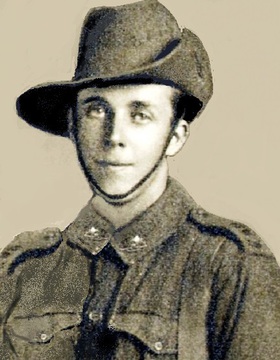
S80342
RUSSELL, Norman John
| Service Number: | 2420 |
|---|---|
| Enlisted: | 23 June 1915 |
| Last Rank: | Private |
| Last Unit: | 27th Infantry Battalion |
| Born: | Thebarton, South Australia, 27 February 1897 |
| Home Town: | Walkerville, South Australia |
| Schooling: | Not yet discovered |
| Occupation: | Gardener |
| Died: | 15 December 1974, aged 77 years, cause of death not yet discovered, place of death not yet discovered |
| Cemetery: |
Dudley Park Cemetery, South Australia |
| Memorials: |
World War 1 Service
| 23 Jun 1915: | Enlisted | |
|---|---|---|
| 13 Oct 1915: | Involvement Private, 2420, 27th Infantry Battalion, --- :embarkation_roll: roll_number: '15' embarkation_place: Adelaide embarkation_ship: HMAT Themistocles embarkation_ship_number: A32 public_note: '' | |
| 13 Oct 1915: | Embarked Private, 2420, 27th Infantry Battalion, HMAT Themistocles, Adelaide |
Help us honour Norman John Russell's service by contributing information, stories, and images so that they can be preserved for future generations.
Add my storyBiography contributed by St Ignatius' College
Before the War:
Norman John Russell, or Norman, was born on the 18th of February 1987 at Thebarton. His hometown was Walkerville, SA but he enlisted in Keswick. He worked as a Gardener before enlisting. He had previously been trained in the 80th Senior Cadets.
There is not much known as the next of kin surrounding him, but his mother, Mrs Ada Russell, in Walkerville SA was listed as his Next of Kin. After enlisting in the Australian Armed Forces, he got assigned an infantry role within the 27th Infantry Battalion.
Personal Description:
He was an 18-year-old male, with a height of 180cm (5’11) and a weight of 67.59kg. He had dark brown hair and blue eyes. During his medical examination, there were no signs of impairments, both visual, mental, or physical. (Attestment Paper, signed on the 23rd of July 1915)
The Battalion:
The 27th Australian Infantry Battalion was a unit that served as part of the Australian Imperial Force. The Battalion was formed in March 1915 and was part of the 7th Brigade, 2nd Australian Division.
The Battalion fought on the Western Front in France and Belgium and encountered engagements including the Battle of Polygon Wood, the Battle of Villers-Bretonneux, the Battle of Amiens and the Battle of Fromelles, where they would suffer heavy losses within the Battalion.
Despite this setback, the 27th Battalion continued to serve on the Western Front for the remainder of the war and was involved in the final attack that led to the German surrender in November 1918. Overall, the Battalion suffered over 2,000 casualties during the war, including 509 soldiers killed in action or dying of wounds and the 27th Battalion was disbanded in March 1919.
His Involvement:
There isn’t much said about the specific battles he fought in, but his combat documents state that he left Australia for Britain on September 14th, 1915. He was sent from Southampton to Marseilles, France, where he then left for Alexandria, Egypt on March 15th, 1916. During the reaminder of 1016 he fought with his Batallion, the 27th. On January 29th, 1917, he was taken to a French hospital and on March 1st, he was diagnosed with level 1 trench feet. He was discharged from the hospital in April and sent to a training camp at Payhem Downes.
On April 26th, he was convicted of being AWL for 24 hours, so he was consequently sentenced to 3 days without pay. From April to March 1918, he was mainly sent to and from training camps, until March 10th, 1918, when he was sent back to the front trenches as a part of a trench line near the Lys River.
April 1st, 1918
Fine weather prevailed: Battalion in the front line opposite Frelinghien. An increase in enemy artillery activity, very little damage was done to our (defence?), and no casualties occurred. Two enemy aeroplanes were active for a short period over our lines, and anti-aircraft guns (dispensed?) them. During the day enemy machine guns and trench mortars were normal. During the night heavy projectiles, from enemy T.M. caused considerable damage to the Kiwi trench and No2 post. Fortunately, no casualties occurred. Battalion strength – 42 Officers, 980 Other Ranks.
Private Russell Norman John was wounded in action on April 1st, 1918, during the Battle of Dernancourt in France. Private John's service record indicates that he suffered a gunshot wound to the right leg and was evacuated to England for medical treatment. After recovering from his wounds, Private John was transferred to the 22nd Battalion and continued to serve on the Western Front until the end of the war.
After the War:
He returned to Australia on May 1st, 1919 and was discharged from the army on June 17th, 1919. For his service in World War I, Private Russell Norman John was awarded the British War Medal and the Victory Medal. He died on the 15th of September 1974 at 77 years old and he was buried at Dudley Park Cemetery, SA.














